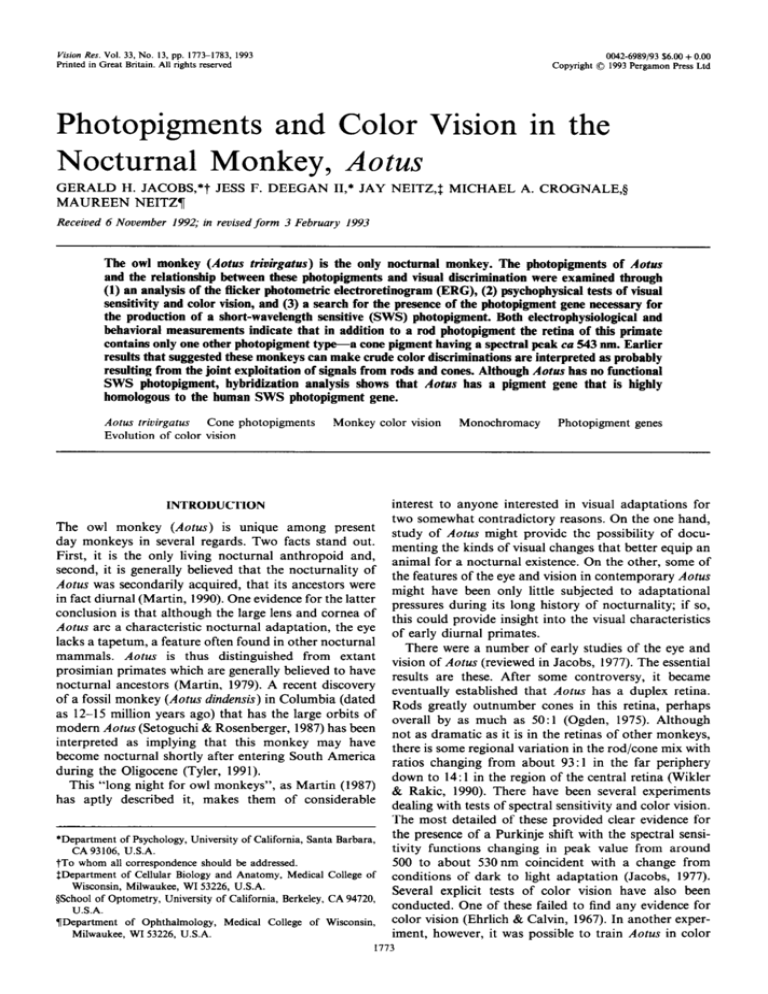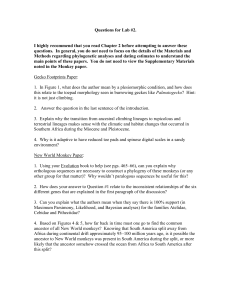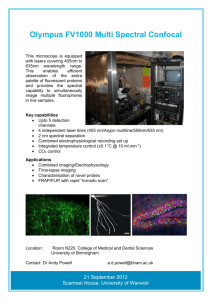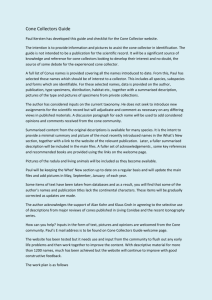
Vision Res. Vol. 33, No. 13, pp. 1773-1783, 1993
Printed in Great Britain. All rights reserved
Copyright
0
0042-6989/93 $6.00 + 0.00
1993 Pergamon Press Ltd
Photopigments and Color Vision in the
Nocturnal Monkey, Aotus
GERALD H. JACOBS,*? JESS F. DEEGAN
MAUREEN NEITZT
II,* JAY NEITZ,$ MICHAEL
A. CROGNALE,§
Received 6 November 1992; in revised form 3 February 1993
The owl monkey (Aotus tridrgutus) is the only nocturnal monkey. The photopigments of Aotus
and the relationship between these photopigments and visual discrimination were examined through
(1) an analysis of the tlicker photometric electroretinogram (ERG), (2) psychophysical tests of visual
sensitivity and color vision, and (3) a search for the presence of the photopigment gene necessary for
the production of a short-wavelength sensitive (SWS) photopigment. Roth electrophysiological and
behavioral measurements indicate that in addition to a rod photopigment the retina of this primate
contains only one other photopigment type-a cone pigment having a spectral peak cu 543 nm. Earlier
results that suggested these monkeys can make crude color discriminations are interpreted as probably
resulting from the joint exploitation of signals from rods and cones. Although Aotus has no functional
SWS photopigment, hybridization analysis shows that A&us has a pigment gene that is highly
homologous to the human SWS photopigment gene.
Aotus trivirgatus
Evolution
Cone photopigments
of color vision
Monkey color vision
INTRODUCTION
The owl monkey (A&us) is unique among present
day monkeys in several regards. Two facts stand out.
First, it is the only living nocturnal anthropoid and,
second, it is generally believed that the nocturnality of
Aotus was secondarily acquired, that its ancestors were
in fact diurnal (Martin, 1990). One evidence for the latter
conclusion is that although the large lens and cornea of
A&us are a characteristic nocturnal adaptation, the eye
lacks a tapetum, a feature often found in other nocturnal
mammals. A&us is thus distinguished from extant
prosimian primates which are generally believed to have
nocturnal ancestors (Martin, 1979). A recent discovery
of a fossil monkey (A&us dirtdensis) in Columbia (dated
as 12-15 million years ago) that has the large orbits of
modern A&us (Setoguchi & Rosenberger, 1987) has been
interpreted as implying that this monkey may have
become nocturnal shortly after entering South America
during the Oligocene (Tyler, 1991).
This “long night for owl monkeys”, as Martin (1987)
has aptly described it, makes them of considerable
Monochromacy
Photopigment
genes
interest to anyone interested in visual adaptations for
two somewhat contradictory reasons. On the one hand,
study of A&us might provide the possibility of documenting the kinds of visual changes that better equip an
animal for a nocturnal existence. On the other, some of
the features of the eye and vision in contemporary A&us
might have been only little subjected to adaptational
pressures during its long history of nocturnality; if so,
this could provide insight into the visual characteristics
of early diurnal primates.
There were a number of early studies of the eye and
vision of A&us (reviewed in Jacobs, 1977). The essential
results are these. After some controversy, it became
eventually established that Aotus has a duplex retina.
Rods greatly outnumber cones in this retina, perhaps
overall by as much as 50: 1 (Ogden, 1975). Although
not as dramatic as it is in the retinas of other monkeys,
there is some regional variation in the rod/cone mix with
ratios changing from about 93 : 1 in the far periphery
down to 14: 1 in the region of the central retina (Wikler
& Rakic, 1990). There have been several experiments
dealing with tests of spectral sensitivity and color vision.
The most detailed of these provided clear evidence for
the presence of a Purkinje shift with the spectral sensitivity functions changing in peak value from around
500 to about 530 nm coincident with a change from
conditions of dark to light adaptation (Jacobs, 1977).
Several explicit tests of color vision have also been
conducted. One of these failed to find any evidence for
color vision (Ehrlich & Calvin, 1967). In another experiment, however, it was possible to train Aotus in color
*Department of Psychology, University of California, Santa Barbara,
CA93106, U.S.A.
tTo whom all correspondence should be addressed.
SDepartment of Cellular Biology and Anatomy, Medical College of
Wisconsin, Milwaukee, WI 53226, U.S.A.
@School of Optometry, University of California, Berkeley, CA 94720,
U.S.A.
T/Department of Ophthalmology, Medical College of Wisconsin,
Milwaukee, WI 53226, U.S.A.
1773
1774
GERALD H. JACOBS et al.
discrimination tasks, though it was difficult to do so.
That study concluded that “color vision in this species
does not appear to be an acute, highly developed,
capacity” (Jacobs, 1977). Based on a consideration of
results from several color tests it was suggested that
A&us might be a severely protanomalous trichromat.
We have been motivated to again examine the question of photopigments and color vision in Aotus. There
are several separate reasons for believing that there
might be more to learn about these issues. (1) Over the
last several years it has become apparent that many
species of platyrrhine monkey have a striking cone
photopigment polymorphism (Mollon, Bowmaker &
Jacobs, 1984; Jacobs & Neitz, 1987a, b; Jacobs, Neitz &
Crognale, 1987; Travis, Bowmaker & Mollon, 1988;
Tovee, Bowmaker & Mollon, 1992). This pigment polymorphism manifests itself behaviorally as individual
variations in color vision. There is no evidence for
individual variation of this sort in any previous studies
of Aotus, but it well could have gone undetected in
the small samples that characterize the earlier work.
Since the polymorphism of photopigments among the
platyrrhines may hold implications for understanding
the evolution of primate color vision (Mollon, 1990;
Jacobs, 1991) it is important to determine if a
platyrrhine with a unique history like Aotus is also
polymorphic. (2) Research on humans reveal many
instances where rods contribute signals in direct tests of
color vision; for instance, in color matching (Smith &
Pokorny, 1977; Nagy, 1980) and color naming (Montag
& Boynton, 1987). These contributions from rods would
seem unusually hard to avoid in subjects like Aotus in
which the retina contains many more rods than cones
and where there is no cone-specialized region of the
retina that can be accessed by focus stimulation. Those
features, in combination with the fact that the earlier
behavioral tests were conducted at modest light levels,
lead to the strong suspicion that rod contributions could
not have been avoided in these studies. If so, it is hard
to know the pigment basis for the color discrimination
behavior reported previously. (3) There have been significant advances in our ability to objectively measure
cone pigments. The technique of electroretinogram
(ERG) flicker photometry (Neitz & Jacobs, 1984) has
now been used to measure cone pigments in the
retinas of a wide variety of species. Unlike many earlier
objective measures, ERG flicker photometry provides
reliable results that correspond well with photopigment
measurements made with other techniques. A further
advantage of this procedure is that the use of high
frequency flicker makes it possible to minimize rod
contribution and thus measure cone signals even in
those retinas that contain modest proportions of cones;
for instance, the cat (Jacobs & Neitz, 1986). (4) A final
motivation for re-examining pigments and color vision
in this monkey emerged only during the course of our
study. Wikler and Rakic (1990) have used cone-specific
antibodies to examine the distribution of cone types in
the retina of Aotus. Although they were able to label
a population of putative middle-wavelength sensitive
(MWS) to long-wavelength sensitive (LWS) cones using
a polyclonal antibody that unselectively labels a mixture
of MWS and LWS cones in other primates, they failed
to label any short-wavelength sensitive (SWS) cones with
another polyclonal antibody that does detect such cones
in other primate retinas. This raises the possibility that
A&us may not have a functional population of SWS
cones. If so, this would be another way in which Aotus
is unique.
We have re-examined the issue of photopigments and
color vision in Aotus by measuring its pigment complement with ERG flicker photometry, by conducting
some tests of visual discrimination, and by searching for
the presence of a gene that might code for the cone opsin
appropriate for producing an SWS photopigment.
METHODS
Subjects
Six adult owl monkeys (A. triuirgatus), two males and
four females, were examined. For purposes of comparison, some measurements were also made on an adult
male squirrel monkey (Saimiri sciureus).
Electrophysiological experiments
Apparatus. Descriptions of the apparatus and general
procedures used in ERG flicker photometry have been
presented (Neitz &Jacobs, 1984; Jacobs & Neitz, 1987a).
Only an abbreviated version is given here. Squarewave light pulses were produced with a three-beam
Maxwellian-view optical system. One beam (test) originated from a high-intensity grating monochromator
(tungsten-halide lamp; half-energy passband = 10 nm).
The others (reference and adaptation sources respectively) were also drawn from tungsten-halide lamps.
All three sources were underrun at 11 V from regulated
d.c. power supplies. The separate beams were optically
superimposed and then focused into the eye through a
Fresnel lens so as to yield a circular spot subtending
57 deg of retinal subtense. High-speed electromagnetic
shutters (Vincent Associates) were placed in the test and
reference beams.
ERGS were differentially recorded from a bipolar
(Burian-Allen type) contact lens electrode. A ground
electrode was placed against the inside of the animal’s
cheek.
In ERG flicker photometry, signals are recorded as
the responses from interleaved trains of light pulses from
the test and reference lights. The pulses from the two
sources are of equal duration and the successive pulses
from these two sources are separated by equal-duration
intervals that contain neither test nor reference light.
Sensitivity measurements were made for different combinations of adaptation state and photometer pulse rate
as specified below. In each case, the goal was to equate
the effectiveness of the test and reference light. The
evoked responses are processed through several stages
(Neitz & Jacobs, 1984). The differentially amplified
signal is passed through an active narrow-bandpass filter
(value = 0.2 x center frequency). The center frequency is
A0TU.S PIGMENTS AND COLOR VISION
equal to the individual modulation frequencies of the test
and reference lights. If (for example) the response to the
test light is smaller than to the reference light the filtered
output is approximately sinusoidal; a large increase in
the intensity of that light shifts the phase of the output
by 180 deg. The operator searches for the intensity of the
test light where the amplitude of the response is minimized and the phase is intermediate. The cancellation of
the two signals is improved by a three-stage subtraction
of the two responses. Finally, the output from the test
light interval is averaged with the inverted output from
the reference light interval and displayed on a computer
monitor.
Procedure. Aotus monkeys were anesthetized with an
i.m. injection of a mixture of ketamine hydrochloride
(20 mg/kg) and acepromazine maleate (0.20 mg/kg).
Recording sessions continued for l-2 hr; during this
time supplementary anesthesia was given as required.
The pupil of the test eye was dilated by topical application of atropine sulfate and phenylephredine HCl. The
animal was positioned for recording by using a specially
designed head holder that eliminated all pressure points
(Neitz & Jacobs, 1984). Normal body temperature was
maintained through the use of a circulating hot-water
heating pad.
Except for the assessments of rod-based vision,
recording was done in a room illuminated by overhead
fluorescent lamps. These yielded an ambient light having
a luminance of 60 cd/m2 at the plane of the cornea.
Additional light adaptation was provided as required for
particular experiments. In the case of explicit studies of
dark adaptation, the room lights were extinguished and
the only light reaching the eye was that produced from
the optical system.
Flicker photometric equations were determined by
recording the last 50 cycles of a total presentation of
70 stimulus cycles (each cycle constituted as described
above). As noted, the amplitude of the averaged
response was varied to yield an equation by positioning
a density wedge in the test beam. This was done
iteratively until the best equation value was determined.
The equation was recorded as the value on the density
wedge (to the nearest 0.01 log unit). Ordinarily, photometric equations were completed for test lights spaced
at 10 nm intervals across the spectrum. Two complete
runs were obtained and the wedge density settings were
averaged together. The equations were quite reliablethe deviation between the two separate readings was
typically < 0.05 log unit. Finally, the averaged equation
values were converted to spectral sensitivity values
by correcting them for the spectral transmittance of
elements in the optical system. The stimulus conditions
for the specific experiments were as follows.
(a) Test for the joint presence of MWS/LWS photopigments: the procedure was similar to that previously
employed for this purpose (Jacobs & Neitz, 1987a).
A flicker photometric equation was made between a
middle wavelength (540 nm) test light and a longer
wavelength (630 nm) reference light (pulse rate = 33 Hz).
These equations were made repeatedly as the eye was
1775
concurrently exposed to steady adapting lights of either
630 or 540 nm. Prior to making the equations, the
intensities of the adapting lights were adjusted so that
each elevated the threshold of a 540 nm light (flickering
at 16.5 Hz) by 0.8 log unit. Six monkeys were tested.
(b) Cone spectral sensitivity functions: complete
spectral sensitivity functions were determined for all six
animals under conditions of light adaptation. The stimulus pulse rate was 33 Hz. The test wavelengths were
taken at 10 nm steps from 450 to 630 nm. The reference
light was achromatic (color temperature = 2600 K;
cornea1 radiance = 128.4 pW/cm*).
(c) Rod spectral sensitivity functions: spectral sensitivity functions reflective of rod function were determined for two Aotus monkeys (both females). To
accomplish this, (1) the room lights were extinguished,
(2) the photometer pulse rate was slowed to 15 Hz, and
(3) the intensity of the reference light was greatly
dimmed (cornea1 radiance = 1.23 p W/cm*). Spectral
sensitivity functions were determined for test wavelengths lying between 450 and 600 nm (10 nm steps).
(d) Test for the presence of an SWS photopigment:
each of the six animals was informally tested and
complete spectral sensitivity functions were obtained
from two Aotus monkeys (one male, one female)
under stimulus conditions designed to elicit signals from
typical SWS cones. The eye was steadily adapted to the
light coming through a high-pass filter (50% transmission = 580 nm). The adaptive effectiveness of this
light is specified below. The reference light was 460 nm
(radiance = 7.4 pW/cm*) and the pulse rate was 15 Hz.
Test wavelengths were 450 to 610 nm. A squirrel monkey
was tested under this same set of conditions.
Behavioral experiments
Apparatus. We used an apparatus
designed for
measuring visual discriminations in animal subjects.
It has been fully described (Jacobs, 1984). In brief,
the subject views three transilluminated panels mounted
along the wall of a small test chamber. The task is a
version of an oddity problem in which two of the panels
are identically illuminated. The third panel is uniquely
illuminated and the animal is reinforced (in this case by
delivery of an 97 mg banana-flavored pellet) for touching
that panel. The three panels are illuminated by an optical
system mounted outside of the test chamber. Over trials
the location of the positive panel is changed randomly.
The magnitude of the difference between the positive
stimulus and the two negative stimuli is titrated to allow
the measurement of thresholds. The light illuminating
the positive panel comes from Instruments SA Inc.
monochromator (half-energy passband = 16 nm) having
a 75 W xenon lamp. All three panels can be equally
illuminated by the output from a tungsten-halide lamp.
The spectral content of this illumination is controlled by
placing filters in the beam. Each of the lamps is run from
a regulated power supply. The optical system is so
configured that the light from the monochromator can
be either added to that coming from the other source
(for tasks such as increment detection) or it can be
1776
GERALD H. JACOBS et
substituted for that light (for color discriminations). The
interior of the test chamber was always ambiently illuminated from a fluorescent tube mounted in the ceiling
(average illuminance = 100 lx). All aspects of stimulus
presentation, response monitoring and reinforcement are
under the program control of a computer.
Procedure. A female Aotus monkey was the subject.
She was tested daily and then fed immediately following
the test session. After initial training, during which
the monkey successfully learned to select the uniquely
illuminated panel, she was tested on two kinds of
experiments.
(a) Increment-threshold spectral sensitivity: complete
spectral sensitivity functions were measured for a series
of different adapting backgrounds. In each of these
cases the background was a steady achromatic (5800 K)
light. The test lights were monochromatic and varied
in 10 nm steps across the spectrum; the total spectral
range covered varied somewhat from background to
background as specified below. The intensity of the test
light was varied in steps of 0.3 log unit; the range of
intensities at each test wavelength was selected so as to
span a range of performance from 80% down to about
40% correct. Each wavelength/intensity combination
was presented as a block of three trials; wavelength
presentation was randomized. A daily session encompassed about 200-250 test trials and testing continued
until the monkey had accumulated 100 trials at each of
the wavelength/intensity combinations.
To derive spectral sensitivity functions from these
data, psychometric functions were drawn for each test
wavelength by best-fitting the averaged discrimination
data with an approximation of the cumulative normal
distribution, the logistic function. The asymptotes for
this function were set at 100% correct and 33% correct
with mean and variance as free parameters. The functions with the mean and variance providing the best
least-squares fit to the data were taken as the best
estimate of performance. Threshold sensitivities were
obtained from the functions by computing the stimulus intensity corresponding
to the 99% level of
confidence.
Spectral sensitivity functions were determined for five
background luminances and spectral ranges: 14 cd/m*
(430-620 nm), 31.5 cd/m2 (430-620 nm), 53.8 cd/m*
(450-610 nm), 125 cd/m2 (450-610 nm) and 267.2 cd/m2
(460-600 nm).
(b) Color discrimination: following determination of
the increment-threshold
spectral sensitivity functions
the monkey was tested to see if she could make color
discriminations. The test apparatus was set to the substitution mode, i.e. the monochromatic light appeared
alone on the positive stimulus panel. The positive lights
varied in wavelength from 480 to 560 nm. The negative
lights were achromatic (53.8 cd/m*; color temperature = 5800 K). The luminance of the monochromatic
lights was randomly varied in successive three-trial
blocks so as to span the value where the positive and
negative lights were calculated to be equally bright (see
below).
al.
Molecular genetic analysis
A molecular genetic search was undertaken to
determine if Aotus has an SWS pigment gene. Hybridization analysis was carried out on 10 fig of DNA
obtained from each of five species: three neotropical
monkeys (A. trivirgatus, S. sciureus, Saguinus fuscicollis),
human, and salmon. The latter was used as a control.
The DNA sample obtained from each species was slot
blotted and subjected to hybridization analysis. The
probe used was a cDNA clone of the human SWS cone
pigment gene derived from plasmid hs37 (Nathans,
Thomas & Hogness, 1986). The hybridization was
carried out at 42°C in 50% formamide, 5 x Denhardts,
5 x SSPE, 0.1% SDS and 100 pg/ml carrier DNA (from
herring testes) for 72 hr. The filter was washed for 2 hr
in four changes of 2 x SSC, 1% SDS at 55°C. Blots from
the five species were scanned with a densitometer.
RESULTS
Electrophysiological
test for multiple MWS/L WS cone
types
This experiment asked whether the cone signals
recorded to middle and long wavelength test lights in
Aotus behaved univariantly in the presence of effective
chromatic adaptation. For each monkey we recorded
the intensity of the 540 nm test light required to null the
response to a 630 nm reference light in the presence of
either 630 or 540 nm adaptation lights. There was no
evidence for a significant chromatic adaptation effect in
any of the six subjects, The mean change in threshold
(without respect to direction) recorded under the two
conditions of adaptation was 0.021 log unit. Of the
individual animals, three showed very small adaptational changes in the direction expected for failures of
univariance (i.e. sensitivity to the 540 nm light was
lowered in the presence of 540 nm adaptation), two
others showed small changes in the opposite direction
(sensitivity higher to the 540 nm light in the presence of
540 nm), and the remaining animal showed no threshold
shift for the two adaptation states. By way of comparison, normal trichromatic humans tested in the same
fashion showed average threshold shifts of 0.12 (Jacobs,
Neitz, Crognale & Brammer, 1991). On the other hand,
squirrel monkeys known to have only a single photopigment in the 540/630 portion of the spectrum give
adaptation effects very much like those for Aotus
(Jacobs & Neitz, 1987a). This test fails to provide
evidence that Aotus has more than one adaptable cone
photopigment in the spectral range 540-630 nm.
MWSIL WS cone spectral sensitivity
Spectral sensitivity functions were recorded from
each of the six monkeys under conditions that would be
expected to minimize contributions from rod photoreceptors and from typical SWS cones-light adaptation
and relatively rapid flicker (33 Hz). The results are
summarized in Fig. 1 which gives the spectral sensitivity
function for each animal. Since the previous experiment
AOTUS PIGMENTS AND COLOR VISION
2.5 -
I
450
I
I
1
I
500
550
500
650
Wavelength (nm)
FIGURE 1. Spectral sensitivity functions for the MWS/LWS cone
pigment of Aotus. Each function summarizes the results obtained from
ERG flicker photometric measurements for one monkey. The solid
circles are the average photometric equations. The continuous line
is the curve for the best-fitting visual pigment absorption function
determined as described in the text; the computed peak of the curve
(in nm) is given to the right of each curve. The individual functions
have been arbitrarily positioned on the ordinate.
suggested Aotus to have only one class of cone absorbing
maximally in the middle to long wavelengths, the array
of sensitivity values obtained from each animal was fit
to the absorption curve appropriate for a single photopigment. The spectral positioning of the pigment was
obtained by shifting the photopigment
absorption
curves provided by Ebrey and Honig (1977) along a
log wavenumber axis (Baylor, Nunn & Schnapf, 1987)
searching for the best fit between the data array and the
pigment curve. The goodness of fit of the pigment curve
to the data set was computed at peak interval steps of
1 nm. The best fitting curves so obtained are shown in
Fig. 1.
The locations of peak sensitivity (&,,,) for each
animal tested in this fashion are given in Fig. 1. With
one exception these curves provide very close fits to the
spectral sensitivity data. That exception (third from the
bottom in Fig. I) also provided the most deviant peak
estimate. For five animals the peak locations varied over
a 3 nm range, from 541 to 543 nm, while for the animal
whose data are the most poorly accounted for by the
pigment curve the ;I,, value was 546 nm. We note this
animal was not atypical in any way in the test for the
presence of more than one MWS/LWS photopigment
(above). Even with the inclusion of the data from that
monkey, the peak sensitivity locations so defined are
quite consistent across animals (mean A,,,,,= 542.5 nm;
SD = 1.87).
Search for the presence of an SWS cone in Aotus
In earlier experiments we found that the contributions
of SWS cones to flicker photometric recordings could
be most efficiently elicited by combining three stimulus
features+oncurrent,
intense long-wavelength adaptation, a somewhat slowed photometer pulse rate, and
1777
a reference light of a wavelength to which the SWS
cone should be quite sensitive (Crognale, Jacobs &
Neitz, 1991). We failed to find any hint of an SWS cone
contribution in any of the six animals, even though we
varied widely (both singly and in combination) the
parameters of each of the three stimulus features just
noted.
Perhaps the best way to document the failure to
elicit SWS cone signals in Aotus is to contrast the result
in this monkey with that obtained from an animal
known to have SWS cones. There is evidence from both
behavioral studies (Jacobs, 1984) and microspectrophotometric (MSP) measurements (Bowmaker, Jacobs
& Mollon, 1987) that all squirrel monkeys have a
population of cones containing an SWS photopigment.
We tested a dichromatic squirrel monkey whose cone
pigment phenotype had been established in an earlier
experiment (Jacobs & Neitz, 1987a) and two of the Aotus
monkeys under exactly the same set of stimulus conditions. The spectral sensitivity functions derived for
these animals are given in Fig. 2. This combination of
conditions dramatically illustrates the contribution of
SWS cones in the squirrel monkey (squares in Fig. 2).
Under these conditions, the squirrel monkey shows a
considerable loss of sensitivity to the long wavelengths,
enough so that he became maximally sensitive to the
short wavelengths. His full spectral sensitivity function
could be best fit by assuming summative contributions
from SWS cones (having a A,_ at 430nm) and LWS
cones having a A,, at 550 nm. By contrast, this same
long-wavelength adaptation (which also caused a large
sensitivity loss in the long wavelengths in Aotus monkeysd.8
log units at 540 nm) uncovered no apparent
contribution from SWS cones in the Aotus monkey.
I
,A
450
,
500
* \
550
500
,
550
Wavelength (nm)
FIGURE 2. ERG flicker photometric spectral sensitivity curves
obtained under stimulus conditions designed to enhance the contribution from SWS cones. These conditions included concurrent intense
long-wavelength adaptation and the use of a short-wavelength reference light (the wavelength of which is indicated by the arrow head
to the right). The solid circles show the spectral sensitivity functions
obtained from two Aotus monkeys. The solid lines are the absorption
curves for the best fitting visual pigment (1,, of 542 and 544 nm
respectively). At the bottom (squares) are sensitivity measurements
obtained from a squirrel monkey with the same choice of test
conditions. These have been corrected for the density of the squirrel
monkey lens and, in this case, the continuous curve represents the
best fitting summative combination of two photopigment absorption
curves (J.,_ = 550 and 430 nm). The results for all three animals are
arbitrarily positioned on the ordinate.
1778
GERAtD
H. JACOBS ef
al.
To the contrary, the full functions for the Aotus monkeys
(solid circles in Fig. 2) are indiscriminable from those
obtained with an achromatic reference light and with
no chromatic adaptation (Fig. 1). These experiments fail
to provide any evidence that Aotus has a functional
population of typical SWS cones.
Rod spectral sensitivity
Spectral sensitivity functions were obtained using
ERG flicker photometry under conditions designed
to elicit signals from rods. Complete functions were
obtained during two separate test sessions from each
of two monkeys. The averaged spectral sensitivity functions are shown in Fig. 3. The continuous lines are the
best-fitting visual pigment absorption curves obtained as
described above. The fits are individually quite good
over the entire spectral range, and the sensitivity peaks
(504 and 506 nm) for the two animals are close together.
increment -threshold spectral sensitivity
The ERG experiments provided positive evidence
for only a single class of cone in the retina of A&us.
Although there is reason to believe otherwise (e.g.
Fig. 2), one might argue that it is possible that the Aotus
retina contains multiple classes of cone, but that only
one of these provides signals that can be recorded in
the ERG. With that possibility in mind, we conducted
several behavioral experiments. In all mammalian
retinas known to contain multiple types of cone receptor,
the outputs from these receptors are processed in the
visual system along two spectrally distinct pathwaysnon-opponent and chromatic-opponent.
The signature
of the latter is very clearly seen in spectral sensitivity
functions measured at increment-threshold. Indeed, the
presence of multiple peaks in such functions is widely
taken as prima facie evidence for the operation of
chromatic-opponent mechanisms (Harwerth & Sperling,
19’71; King-Smith & Carden, 1976).
The five spectral sensitivity functions measured for
this subject are shown in Fig. 4 where they are arranged
in order of the increasing intensity of the background
I
450
SO0
550
BOO
Wavelength(nm)
FIGURE 4. Five increment-threshold spectral sensitivity functions
obtained from a single Aom monkey. The parameter is the luminance
of the adaptation light (from top to bottom the background was
increased over a total range of 1.28 log units). The data points have
been best-fitted using visual pigment absorption curves (continuous
lines). The functions are arbitrarily positioned along the ordinate.
light from top to bottom. None of these functions show
any obvious discontinuities in shape. Because of that
fact, the sensitivity values (solid circles) were fit to
absorption curves for individual photopigments using
the procedure outlined previously. For each of the five
sets of data the solid lines give the best-fitting pigment
absorption curves. As can be seen, these curves provide
reasonable accounts of the sensitivity data. The peaks
for these best fit functions varied only slightly (from 532
to 535 nm) as the intensity of the background light was
varied over a 1.28 log unit range.
Because there was little evident variation in these
spectral sensitivity functions, the separate functions were
averaged after having been first equated so as to have
the same average sensitivity. These averaged data were
again best fit to a pigment absorption curve (Fig. 5).
These functions lack entirely the characteristics one
3.0 +-
p
2.5
-
e
0)
v)
2.0
-
s
P
B(0
1.5 -
k
A
1.0 -
0.5
-
t
I
450
1
I
I
1
500
550
600
6.50
Wavelength (nm)
FIGURE 3. ERG flicker-photometric spectral sensitivity functions for
two Aorus monkeys recorded under conditions of dark adaptation.
As in Fig. 1, the continuous lines are the best fitting photopigment
absorption Curves the peak values of which are indicated.
FIGURE 5. The average increment-threshold spectral sensitivity
function for the Aorus monkey. The data points (squares) represent
sensitivities averaged across the five functions of Fig. 4. The ~st-~tting
visual pigment absorption curve has a peak value of 533 nm. Shown
above (circles) is an increment-threshold function similarly measured
for an individual saddle-backed tamarin (from Jacobs et al., 1987).
The data points obtained from the tamarin have been best fit by
the subtractive combination of two photopigment absorption curves
having peak values of 433 and 543 nm.
AOTUS PIGMENTS AND COLOR VISION
1779
would expect if spectrally-opponent
mechanisms contributed to increment-threshold
discrimination in the
Aotus monkey. Specifically, the combination of signals
from a cone absorbing maximally at around 540 nm
and a typical SWS cone would yield, in addition to the
peak in the middle wavelengths, a clear secondary peak
in the short wavelengths and a distinctive notch in the
function in the vicinity of 480-500 nm. Exactly those
features were seen in dichromatic monkeys earlier tested
in this same discrimination apparatus. The results from
one such animal (determined at a background light level
0.0
of 25 cd/m’) are shown in Fig. 5 where they provide
0.3
Teat L:;nt At&non
a counterpoint to the results from Aotus. The retina of
that monkey, a saddle-backed tamarin (S. ~~~c~c~~~~~),FIGURE 6. Illustration of the method used to obtain brightness
equations. The monkey had been previously trained, to select the
contained two classes of cone pigment with respective
brighter of three lights. The test light (540nm) was progressively
Lmaxvalues of about 543 and 430 nm (Jacobs et al., 1987). decreased in intensity (attenuation steps of 0.1 log unit) from a level
The results of these experiments again fail to provide
where the animal consistently selected (0.0; left) the test light to a level
evidence that Aotus has a second class of cone with peak where that light was consistently avoided (0.3; right). The attenuation
corresponding to chance behavior (small arrow) is presumed to define
sensitivity in the short wavelengths.
A test of color vision
Following the increment-threshold measurements an
explicit test of color vision was conducted. As noted
above, we sought to see if the monkey could discriminate
between monochromatic and achromatic lights. A first
step was to obtain an estimate of the intensity relationships required for the subject to judge the monochromatic and achromatic lights as equally bright. To
accomplish this, the test was changed so that the positive
(monochromatic) light was presented as a substitute for
one of the three achromatic lights, rather than being
added to it as in the previous experiment. Given that the
animal had been thoroughly trained to pick the brighter
of the three lights, then, from the subjects perspective,
as long as the positive light was brighter than that of the
two negative lights the task was equivalent to that of
the increment-threshold
test. However, as this monochromatic light was progressively attenuated one would
expect to reach a level where the two achromatic lights
were actually brighter. At that point, the animal should
now avoid the monochromatic light and consistently
select one or the other of the achromatic lights.
The results of this procedure are shown in Fig. 6.
As expected, the selection of the monochromatic light
varies from consistently positive to a consistently negative choice. We presume that the intensity of the monochromatic light indicated by the arrow in Fig. 6 captures
the location where that light and the two achromatic
lights are about equally bright for this subject.
With a brightness equation established, the animal
was then extensively retrained with the test wavelengths
alternately presented at intensities substantially above
and below the point of equal brightness. Eventually the
monkey learned to correctly select the monochromatic
lights irrespective of whether they were brighter or
dimmer than the achromatic lights. At that point the
full range of intensities between two end points was
tested, initially in rather large steps and then, eventually,
in steps of 0.1 log unit. At the point where performance
appeared asymptotic, an additional 130 trials were
the point where the test light and the comparison light (achromatic,
53.8 cd/m’) are judged equally bright.
accumulated at each of the wavelength/intensity combinations. Figure 7 (top) shows the results for three test
wavelengths. Although this task proved to be difficult
for this monkey, performance was consistently poorer
at the location of calculated equal brightness. This was
true for each of nine test wavelengths (480-560 nm at
10nm steps). The bottom panel of Fig. 7 shows the
results averaged across all of these test wavelengths.
The result is clear in that this monkey failed to
show consistently successful discrimination between the
monochromatic and achromatic lights at the point of
550
55
50
45
---.
40
TV
35
t,
+0.3
.
.
.
.
,
.
+0.2
+0.1
0.0
-0.1
-0.2
-0.3
Teat Light Intennlty
FIGURE 7. Results from a color discrimination test. Top: discrimination of each of three mon~hromatic
lights from an achromatic
light. The test light intensity is defined so as to bracket (in steps of 0.1
log unit) the location of equal brightness (indicated as 0.0). Bottom:
average discrimination data obtained for nine monochromatic lights
versus an achromatic light. 0.0 is the location of equal brightness.
The vertical bars enclose +2 SEM. The level of chance performance
(95% confidence level) is indicated by the dashed line to the left.
GERALD
1780
H. JACOBS
equal brightness. As intensity was varied away from
this point so as to provide a potential brightness cue,
performance improved. Note that the pattern of failure
is approximately symmetric around the location of
presumed equal brightness.
Search for an SWS cone pigment gene
The results of the hybridization analysis are shown
in Fig. 8 in the form of the slot blots obtained from
each of the species. DNA derived from each of the four
primates hybridized to the human SWS pigment gene
probe. Expressed as a percentage of the total density of
the blot obtained from the human subject, the three
neotropical monkeys were as follows: Aotus (37%)
squirrel monkey (31%), tamarin (7%). The salmon
DNA was included as a control for spurious non-specific
hybridization. Densitometry showed the non-specific
hybridization to be undetectable. With respect to the
Aotus monkey the result seems clear-this species has a
pigment gene that is highly homologous to the human
SWS photopigment gene.
DISCUSSION
The results from these several experiments provide a
clear and consistent picture of cone pigments and their
behavioral consequences in Aotus. This differs in several
ways from our expectation based on previous measurements on these monkeys and on our understanding of
cone pigments and color vision in other platyrrhine
monkeys.
A single cone pigment in Aotus
Based on a previous behavioral study on Aotus carried
out in this laboratory (Jacobs, 1977) we expected to find
evidence for more than one cone type. It is, of course,
always difficult to prove that a certain cell type does not
exist, particularly if there is the possibility that it might
be only minimally represented. Even so, the evidence
that Aotus has a single MWS/LWS cone and lacks an
-Salmon
-Human
- Tamarin
-
Aotus
-Squirrel
monkey
FIGURE
8. Results from the hybridization
analysis.
The probe
was a cDNA clone of the human SWS cone pigment gene. Ten
micrograms
of DNA from each animal were slot blotted. Hybridization was carried out as described in the text. The filter was exposed
to preflashed X-ray film (Kodak, XARS) for 24 hr at - 70°C with an
intensifying
screen. The developed X-ray film was scanned with a
Biorad 620 videodensitometer.
et al.
SWS cone altogether seems quite strong. This is so partly
because the techniques employed in an attempt to see
functional contributions from these cone types to both
retinal signals and behavioral discriminations are those
that are generally effective, but even more so because
we have employed precisely these procedures in studies
on many other species (for e.g. Figs 2 and 4). The results
of the comparative search for SWS cone signals in
squirrel monkey and Aotus monkey shown in Fig. 2
are particularly compelling, because in the case of
the squirrel monkey there is good evidence on both the
spectral positioning of the cone pigments and on the
relative representation of the different cone types. Based
on MSP samples it appears that the SWS cones make
up about 5% of all of the cones in the squirrel monkey
retina (Bowmaker, Jacobs & Mollon, 1987). Given the
ease with which that relatively small cone complement
can be detected by ERG flicker photometry, it seems
unlikely that even a small number of SWS cones
could have gone undetected in Aotus. Similar arguments
could be advanced for the comparison of behavioral
data from Aotus and another platyrrhine summarized
in Fig. 4.
If one accepts that these experiments indicate Aotus
to have only a single cone type, then what is the
explanation for the earlier behavioral results showing
these monkeys succeeding at making color discriminations? One that we believe can be rejected is that, for
whatever reason, the monkeys of the older experiment
had a different set of cone photopigments than did
the animals whose results are reported here. We base
this belief on a comparison of the increment-threshold
function measured in this experiment (Fig. 4) and that
reported earlier (Jacobs, 1977, Fig. 4). Although there
were fewer spectral points tested in the earlier experiment, the increment-threshold
function is plausibly
fit by a photopigment absorption curve having a peak
value of 527 nm. This is quite similar to the 532 nm peak
obtained for the background luminance in this study
that is closest to that of the earlier determination. Most
importantly, in the earlier experiment, as in this one,
there is no pronounced elevation of sensitivity in the
short wavelengths of the sort expected from an animal
that has typical SWS cones (as in Fig. 5).
Perhaps the most reasonable post hoc interpretation
of the difference between the outcomes of the two
investigations is that the earlier experiments allowed the
monkey to use rod and cone-based signals to successfully
discriminate between stimuli of different spectral energy
distributions. We noted above that there is considerable
evidence from human psychophysics to show that rod
signals can be used in classical tests of color vision. One
difference between the early experiments and the current
ones that adds to the plausibility of this explanation is
that by virtue of changes in the test apparatus it was
possible to run these new discrimination tests at
significantly higher light levels: the luminance of the
achromatic light used in the color test of Fig. 7 was 1.5
to 0.85 log units higher than that employed in two tests
of color vision conducted in the 1977 study.
AOTUS PIGMENTS AND COLOR VISION
Whether the earlier results can be so explained
remains a matter for conjecture. To the extent they can,
they open the possibility that Aotus monkeys might be
able to make effective joint use of rod and cone signals
at the transitional levels where both receptor types are
operative. In some parts of its geographic range Aotus is
active during crepuscular hours (Wright, 1989), and thus
it might not be uncommon for this animal to encounter
light levels of the sort that would allow the use of
joint rod/cone signals. The possibility that Aotus might
achieve some of the advantages of a kind of rudimentary
color vision by using such signals provides an intriguing
topic for further investigation.
There remains a small difference in the estimate of the
spectral positioning of the cone pigment of Aotus made
from ERG and behavioral measurements. As judged
from the increment-threshold
measurements, average
spectral sensitivity is best fit by a pigment curve with
a peak at about 533 nm, but when this same animal
was examined with ERG flicker photometry her curve
showed a peak of 541 nm. The ERG measurements seem
more likely to securely isolate cone signals, and thus
we believe the figures derived from those measurements
are the better estimate of the spectral location of the
Aotus cone pigment. It seems possible that even on
the brightest backgrounds used there may still be some
small rod contribution to the increment-threshold judgments. We note for the record that the shortest of the
increment-threshold measurements (&,,, = 532 nm) was
obtained on the dimmest background while the longest
such estimate (535 nm) was on the brightest background
tested.
S WS pigment gene and S WS pigment
Our experiments support the conclusions of Wikler
and Rakic (1990) that the Aotus retina lacks a population of SWS cones. Although the retina of the Aotus
seems not to have an SWS pigment that can produce
functional signals, the hybridization experiments (Fig. 8)
suggest that this animal has a gene highly homologous
to a gene that would be expected to produce the opsin
necessary for an SWS photopigment. One concern in
reaching this conclusion is whether the other cone
pigment gene of the Aotus (i.e. the one encoding the
opsin for the 543 nm pigment) might provide the basis
for the hybridization signal seen in Fig. 8. We think that
is not the case because the human SWS cone pigment
cDNA and the Aotus long-wavelength pigment gene
have a low degree of homology, and thus would not
be expected to hybridize under the conditions of this
experiment. The nucleotide sequences of exons 2-5
(those encoding the most highly conserved regions of
the pigments) of the Aotus long-wavelength pigment and
the human SWS pigment cDNA are 41% homologous
(unpublished results). Human SWS and human MWS/
LWS pigment genes are also about 41% homologous
across this region. Under hybridization conditions similar to those we employed, Nathans et al. (1986) found
that the coding sequences of the human SWS and
X-linked pigment genes do not cross-hybridize.
1781
Why the apparent SWS-pigment gene in the Aotus
is not translated into a usable product is not known.
One possible reason for this failure of operation is
suggested by recent investigations of the genetic basis of
human tritanopia (Weitz, Miyake, Shinzato, Montag,
Zrenner, Went & Nathans, 1992b; Weitz, Went &
Nathans, 1992a). This is a rare autosomal dominant
disorder of color vision characterized by an absence of
SWS cone sensitivity. From an analysis of the gene
structure in individuals who suffer this disorder, Weitz
et al. concluded that point mutations that produce
amino acid substitutions in the SWS cone opsin cause
tritanopia. Among other possibilities, this kind of defect
could also account for the discrepancy between the
presence of SWS genes and a functional SWS cones in
Aotus.
The rod pigment in Aotus
The ERG measurements made under conditions
that strongly favor rod signals yield spectral sensitivity
functions with an average peak value of about 505 nm.
This corresponds quite well with behavioral measurements of scotopic spectral sensitivity functions made on
two animals (Jacobs, 1977). Although based on fewer
spectral points than the ERG measurements, those
earlier behavioral data are reasonably captured by
photopigment absorption curves with similarly located
peaks (500 and 503 nm for the two subjects). These
measurements would suggest that the rod pigment of
Aotus is a typical mammalian rhodopsin. That is not,
however, the conclusion reached from recent measurements of Aotus photopigment made with fundus reflectometry (Kemp & Jacobson, 1991). These measurements
yielded a considerably longer pigment peak estimate of
about 518 nm. Since there is no way to separate rod and
cone pigment contributions with densitometric measurements, one possible reconciliation of the two sets of data
is that the densitometric measurements yielded a spectrum based on contribution both from the 542 nm cone
pigment and from a rod pigment absorbing maximally
in the vicinity of 500 nm. The combination of these two
signals could yield a spectrum with a peak intermediate
to the two photopigments.
Absence of photopigment polymorphism in Aotus
Although many species remain unstudied, it appears
that polymorphism of MWS/LWS cone pigments is a
common (if not routine) feature of vision among
platyrrhine monkeys and all of these species have three
classes of such cone pigments (Jacobs, 1991). We failed
to find evidence of any significant individual variation in
cone pigment complement in the Aotus monkeys tested.
The squirrel monkey is the only platyrrhine species for
which sufficient animals have been examined that one
can estimate the incidence of the color vision polymorphism as well as that of the controlling genes. Based
on tests of a large sample of animals, it was concluded
that the three X-chromosome genes coding for cone
pigment opsins are equally frequent in the squirrel
monkey population (Jacobs & Neitz, 1987a). On the
1782
GERALD
H. JACOBS
assumption that this may also be the case for other
platyrrhine monkeys, one can evaluate the likelihood
of obtaining the results we did from A&us. Ten
X-chromosomes were represented in this sample and
all of these apparently (Fig. 1) must contain the same
photopigment
gene. This outcome would be very
unlikely (P = 1.53 x lo-‘) if A&us in fact had a photopigment polymorphism of the sort characteristic of
other platyrrhine monkeys. Although the sample size
precludes rejecting the idea that A&us might show some
low-frequency cone pigment polymorphism, for instance
of the sort found in color-defective humans, the data
are consistent with the conclusion that this species does
not have the kind of cone pigment and color vision
polymorphism recently established as a hallmark of
other neotropical monkeys.
Aotus and the evolution of color vision
Current evidence indicates that Old and New World
monkeys are at different stages in the evolution of color
vision (Jacobs, 1991). In so far as is known, the Old
World monkeys are routinely trichromatic, reflective
of the presence of at least two different X-chromosome
cone pigment genes. By contrast, although there are
multiple photopigment genes and a color vision polymorphism in the population, the majority of New World
monkeys are dichromatic because there is only a single
type of gene on any X-chromosome. A fraction of the
females are heterozygous for these genes, thereby escaping dichromacy and becoming trichromatic. It is possible
to imagine, although by no means required, that the
contemporary
arrangement seen in the platyrrhines
could have characterized an earlier stage in the evolution
of catarrhine color vision.
The arrangement of genes, pigments and color vision
in Aotus make it unique among the monkeys. As we
noted, the fossil record suggests that Aotus may have
become nocturnal at some point early in platyrrhine
history. A possible interpretation is that the nocturnal
life style of Aotus rendered it resistant to the visual
advantages of photopigment polymorphism experienced
by the other diurnal species and, thus, that the
multiple MWS/LWS pigments characteristic of most
neotropical monkeys have arisen only during the
platyrrhine radiation.
Comparisons of the sequences of the photopigment
genes for several primates and other species has led to
the view that the divergence of MWS/LWS pigment
genes from a single gene is a relatively recent event
(Nathans et al., 1986; Yokoyama & Yokoyama, 1989).
Given that, what was the spectral positioning of the
primordial MWS/LWS primate cone pigment? Based
on the observation that the only cone pigment position
known to be common to all contemporary primate
species was one having peak sensitivity around
560-565 nm, we earlier suggested that a pigment at
that position might have served as the progenitor of
the modern MWS/LWS pigments (Jacobs et al., 1987).
The results here, and other recent findings, lead us
to suggest another possibility-that
a pigment having
et al.
the spectral location of the Aotus cone @,,, of
ca 542-543 nm) might prove a better candidate for the
ancestral MWS/LWS primate pigment. We base this
claim on two facts: (1) as noted above, the cone pigments
of Aotus may have been subject to only modest pressures
for change, thus preserving the primitive MWS/LWS
pigment; (2) there is recent evidence that this same
pigment is the only MWS/LWS pigment found in the
retinas of two species of diurnal prosimian, brown and
ring-tailed lemurs (Deegan & Jacobs, 1992). As more
primate pigment gene sequences are accumulated it
should be possible to objectively answer this question.
Finally, the fact that Aotus appears to lack a viable
SWS cone even though it seems to have an SWS pigment
gene may hold general implication for the evolution of
mammalian color vision. Based on the distribution of
color vision it has been argued that dichromacy is the
baseline mammalian condition (Jacobs, 1981, 1993). A
point of concern to this argument is to establish which,
if any, vestiges of cone-based vision were maintained
throughout the long period of mammalian nocturnality.
If it is true that dichromacy is the mammalian norm, and
that this simply reflects the situation characteristic of the
protomammals, how is one to understand those contemporary species that have no color vision? To the
extent that Aotus serves as a model, it may be that each
of these involves some failure in the ability to produce
one of the classes of cone pigment. It will be of interest
to see if other nocturnal mammals have an SWS
gene/pigment discontinuity of the sort here documented
for the Aotus monkey.
REFERENCES
Baylor, D. A., Nunn, B. J. & Schnapf, J. L. (1987). Spectral sensitivity
of cones of the monkey Macaca fasicularis. Journal of Physiology,
390, 1455160.
Bowmaker,
J. K., Jacobs,
G. H. & Mollon,
J. D. (1987).
Polymorphism
of photopigments
in the squirrel monkey: A sixth
phenotype.
Proceedings of the Royal Society of London B, 231,
383-390.
Crognale, M. A., Jacobs, G. H. & Neitz, J. (1991). Flicker photometric
ERG measurements
of short wavelength sensitive cones. Documenta
Ophthalmologica Proceedings, IO, 341-346.
Deegan, J. F. II & Jacobs, G. H. (1992). Photopigments
underlying
color vision in diurnal prosimians.
Investigative Ophthalmology and
Visual Science, 33, 703.
Ebrey, R. G. & Honig, B. (1977). New wavelength-dependent
visual
pigment nomograms.
Vision Research, 27, 147-151.
Ehrlich, A. & Calvin, W. H. (1967). Visual discrimination
behavior in
galago and owl monkey. Psychonomic Science, 9, 5099510.
Harwerth,
R. S. & Sperling, H. G. (1971). Prolonged color blindness
induced by intense spectral lights in rhesus monkeys. Science, 174,
520-523.
Jacobs, G. H. (1977). Visual capacities
of the owl monkey (Aotus
trivirgatus). I. Spectral sensitivity and color vision. Vision Research,
17, 811-820.
Jacobs, G. H. (1981). Comparative color vision. New York: Academic
Press.
Jacobs, G. H. (1984). Within-species
variations
in visual capacity
among squirrel monkeys (Saimiri sciureus): Color vision. Vision
Research, 24, 1267-1277.
Jacobs, G. H. (1991). Variations
in colour vision in non-human
primates. In Foster, D. H. (Ed.), Inherited and acquired colour vision
deficiencies (pp. 199-214). London: Macmillan Press.
AOTUS
PIGMENTS AND COLOR VISION
Jacobs, G. H. (1993). The distribution and nature of colour vision
among the mammals. Eiological Reuiews. In press.
Jacobs, G. H. & Neitz, J. (1986). Spectral sensitivity of cat cones to
rapid flicker. Experimental Brain Research, 62, 446-448.
Jacobs, G. H. & Neitz, J. (1987a). Inheritance of color vision in a
New World monkey (Saimiri sciureus). Proceedings of the National
Academy of Sciences U.S.A.,
84, 2545-2549.
Jacobs, G. H. & Neitz, J. (1987b). Polymorphism of the middle
wavelength cone in two species of South American monkey: Cebus
apella and Callicebus moloch. Vision Research, 27, 1263-1268.
Jacobs, G. H., Neitz, J. & Crognale, M. A. (1987). Color vision
polymorphism and its photopigment basis in a Callitrichid monkey
(Saguinus fuscicollis).
Vision Research, 27, 2089-2100.
Jacobs, G. H., Neitz, J., Crognale, M. A. & Brammer, G. T. (1991).
Spectral sensitivity of vervet monkeys (Cercopithecus aerhiops
sabeus) and the issue of catarrhine trichromacy. American Journal
of Primatology, 23, 185-195.
Kemp, C. M. & Jacobson, S. G. (1991). The distribution and kinetics
of visual pigments in the owl monkey retina. Experimental Eye
Research, 52, 329-335.
King-Smith, P. E. & Carden, D. (1976). Luminance and opponentcolor contributions to visual detection and adaptation and to
temporal and spatial integration. Journal of the Optical Sociery of
America, 66, 709-717.
Martin, R. D. (1979). Phylogenetic aspects of prosimian behavior.
In Doyle, G. A. & Martin, R. D. (Eds), The study of prosimian
behavior. New York: Academic Press.
Martin, R. D. (1987). Long night for owl monkeys. Nature, 326,
639640.
Martin, R. D. (1990). Primate origins and evolution. Princeton, N.J.:
Princeton University Press.
Mellon, J. D. (1990). “Tho’ she kneel’d in that place where they
grew. . ” The uses and origins of primate colour vision. Journal of
Experimental Biology, 146, 21-38.
Mollon, J. D., Bowmaker, J. K. &Jacobs, G. H. (1984). Variations of
colour vision in a New World primate can be explained by polymorphism of photopigments. Proceedings of the Royal Society of
1783
Neitz, J. & Jacobs, G. H. (1984). Electroretinogram measurements of
cone spectral sensitivity in dichromatic monkeys. Journal of the
Optical Society of America, A, I, 1175-l 180.
Ogden, T. E. (1975). The receptor mosaic of Aotes triuirgatus:
Distribution of rods and cones. Journal of Comparative Neurology,
163, 165-183.
Setoguchi, T. & Rosenberger, A. L. (1987). A fossil owl monkey from
La Venta, Colombia. Nature, 326, 692-694.
Smith, V. C. St Pokomy, J. (1977). Large-field trichromacy in protanopes and deuteranopes. Journal of the Optical Society of America,
67, 213-220.
Tovee, M. J., Bowmaker, J. K. & Mollon, J. D. (1992). The relationship between cone pigments and behavioural sensitivity in a New
World monkey (Callithrix jacchus jacchus). Vision Research, 32,
867-878.
Travis, D. S., Bowmaker, J. K. Jr Mollon, J. D. (1988). Polymorphism
of visual pigments in a callithrichid monkey. Vision Research, 28,
481-490.
Tyler, D. E. (1991). The evolutionary relationships of Aofus. Poliu
Primatologica, 56, 50-52.
Weitz, C. J., Went, L. N. & Nathans, J. (1992a). Human tritanopia
associated with a third amino acid substitution in the blue sensitive
visual pigment. American Journal of Human Genefics, 51,
444446.
Weitz, C. J., Miyake, Y., Shinzato, K., Montag, E., Zrenner, E.,
Went, L. N. & Nathans, J. (1992b). Human tritanopia associated
with two amino acid substitutions in the blue sensitive opsin.
American Journal of Human Genetics, SO, 498-507.
Wikler, K. C. & Rakic, P. (1990). Distribution of photoreceptor
subtypes in the retina of diurnal and nocturnal primates. Journal of
Neuroscience,
IO, 3390-3401.
Wright, P. C. (1989). The nocturnal primate niche in the New World.
Journal of Human Evolution, 18, 635-658.
Yokoyama, R. & Yokoyama, S. (1990). Convergent evolution of the
red- and green-like visual pigment genes in fish, Asryunax fusciatus,
and human. Proceedings of the National Academy of Sciences,
U.S.A., 87, 9315-9318.
London B, 222, 373-379.
Montag, E. D. & Boynton, R. M. (1987).Rod influence on dichromatic
surface color perception. Vision Research, 27, 2153-2162.
Nagy, A. L. (1980). Large-field substitution Rayleigh matches of
dichromats. Journal of the Optical Society of America, 70, 778-784.
Nathans, J., Thomas, D. & Hogness, D. S. (1986). Molecular genetics
of human color vision: The genes encoding blue, green and red
pigments. Science, 232, 193-202.
Acknowledgemenrs-This
study was supported by a grant from the
National Science Foundation (BNS-8910062). During the preparation
of the report GHJ was a Guest Research Fellow of the Royal
Society at the Department of Experimental Psychology, University of
Cambridge.









